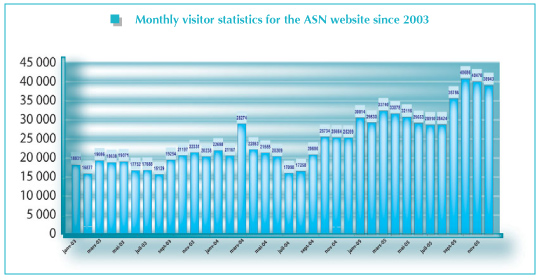For the first time, the ASN has carried out a programme of information with the general public concerning the organisation of nuclear supervision in France. As part of the iodine tablets distribution campaign held in 2005, nearly 500,000 homes near the 19 nuclear power plants received a brochure presenting the supervisory procedures in place for the plant concerned. Public information and transparency concerning nuclear activities should be further enhanced with the nuclear transparency and safety bill, which is shortly to be tabled before Parliament by the Minister for Ecology and Sustainable Development. This text recognises the public's right to access the information in the possession of the nuclear installation licensees and those responsible for radioactive material transport. |
||
| |
1.2 | Laboratory approval |
| 1.2.1 The ASN website: www.asn.gouv.fr | ||
The ASN opened its website, www.asn.gouv.fr, on 2 May 2000. This site is updated in real time and provides the latest news on nuclear safety and radiation protection in France: events occurring in civil nuclear facilities, press releases, decisions and formal notices issued by the ASN, and the stance it has adopted on various subjects. A web user living near a nuclear facility will find all relevant local information in the "Regions" section. The website also presents the assignments of the ASN, the scope of its activities, its publications, the legislative and regulatory texts which govern its daily actions and its relations with foreign counterparts. The CLIs and the CSSIN also each have a section, for which they have editorial responsibility, accessible from the site's home page. |
||
 |
||
Since 1 January 2002, and in line with its commitment to transparency, the ASN website www.asn.gouv.fr has published the results of all the inspections (about 670 per year) carried out by its inspectors in the basic nuclear installations (BNIs), by placing on-line the letters sent to the licensees following each inspection. Since 5 April 2005, the ASN has also placed on-line the information notices concerning EDF reactor outages. In these information notices, it gives the context of the outage, the main worksites involved, the supervision and monitoring actions it carried out and the main events that occurred during the outage. These notices are published after the ASN has approved restart of the reactor concerned. The Nuclear Safety Authority also wishes to expand consultation of the stakeholders and inform the public when drafting general regulatory texts. Therefore, following on from the experiments begun in 2003, it placed the draft National radioactive waste and reusable materials management plan (PNGDR-MV) on-line for consultation, in July 2005. In September 2005, the ASN also placed on its website, for consultation, a draft decree concerning the licensing and declaration conditions for nuclear activities and their supervision, which in particular modified the Public Health Code. Since it was first set up in May 2000, the ASN website has seen its audience steadily grow, a phenomenon which has been even more evident since 1 January 2005. For 2005, the average number of monthly visitors to www.asn.gouv.fr stood at more than 33,500 and the site was visited by more than 400,000 people. In 2004, there were on average 22,000 monthly visitors to the ASN website. This represents a 50% increase, which is the highest rate of growth since May 2000. Other innovations on the ASN website in 2005 included the creation of a "Press conferences" section, publication on the "Regions" pages of information about ASN supervision of the nuclear power plants operated by EDF, the NuPEER international symposium of 22 and 23 June 2005 devoted to nuclear power plant ageing, a revamp of the "Texts" section and updating of the CLI section. The "Texts" section gives the web user access to the regulations covering nuclear safety and protection against ionising radiation. As part of the work being done to create the national environmental radioactivity measurements network, the ASN is also continuing to develop the joint portal with the IRSN which will give access not only to a variety of information concerning the network and its objectives, but also to radioactivity measurements and their interpretation in terms of impact. |
||